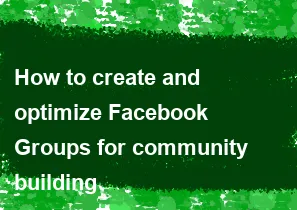How to create and optimize Facebook Groups for community building

Creating and optimizing Facebook Groups for community building involves several key steps. A well-managed Facebook Group can be a powerful tool for connecting people with shared interests or goals. Here's a step-by-step guide to help you create and optimize a Facebook Group for community building:
1. Define Your Purpose and Audience:
- Clearly define the purpose and goals of your group.
- Identify your target audience and understand their needs and interests.
2. Create the Group:
- Log in to your Facebook account.
- Click on the '+' icon in the top right of Facebook and select 'Group.'
- Set up the basic information for your group, including the name, privacy settings, and description.
3. Choose the Right Privacy Settings:
- Decide on the privacy settings based on your group's goals:
- Public: Anyone can see the group, its members, and their posts.
- Closed: Anyone can find the group and see who's in it, but only members can see posts.
- Secret: Only members can find the group, see who's in it, and see posts.
4. Design an Engaging Group Cover and Profile Picture:
- Use high-quality images that represent the group's theme.
- Ensure the cover and profile pictures are visually appealing and convey the group's purpose.
5. Craft a Compelling Group Description:
- Clearly articulate the purpose and rules of the group in the description.
- Mention any guidelines for posting, member behavior, and community engagement.
6. Create and Pin Welcome Posts:
- Post a welcome message introducing yourself and explaining the group's purpose.
- Pin the welcome post to the top of the group to ensure new members see it first.
7. Encourage Member Participation:
- Prompt members to introduce themselves and share their interests.
- Use engaging questions to spark conversations.
- Encourage members to post relevant content and share their experiences.
8. Moderate Effectively:
- Set clear and fair rules for the group.
- Appoint moderators to help manage and enforce group guidelines.
- Regularly monitor and moderate posts to maintain a positive and respectful environment.
9. Promote Your Group:
- Share the group on your personal profile.
- Promote the group in relevant communities or forums.
- Consider using Facebook ads to reach a wider audience.
10. Utilize Group Features:
- Use features like events, polls, and announcements to keep members engaged.
- Experiment with different post types to encourage interaction.
11. Measure and Adjust:
- Monitor group analytics to understand member engagement.
- Use feedback from members to make improvements.
- Adjust your approach based on the evolving needs of the community.
12. Foster a Positive Community Culture:
- Lead by example and encourage positive interactions.
- Acknowledge and celebrate member achievements and contributions.
By following these steps, you can create a vibrant and engaged community within your Facebook Group. Remember that building a community takes time, so be patient and consistently work towards fostering a positive and supportive environment.
-
Popular Post
- How to optimize for Google's About This Result feature for local businesses
- How to implement multi-language support in an Express.js application
- How to handle and optimize for changes in mobile search behavior
- How to handle CORS in a Node.js application
- How to use Vue.js with a UI framework (e.g., Vuetify, Element UI)
- How to configure Laravel Telescope for monitoring and profiling API requests
- How to create a command-line tool using the Commander.js library in Node.js
- How to implement code splitting in a React.js application
- How to use the AWS SDK for Node.js to interact with various AWS services
- How to use the Node.js Stream API for efficient data processing
- How to implement a cookie parser middleware in Node.js
- How to implement WebSockets for real-time communication in React
-
Latest Post
- How to implement a dynamic form with dynamic field styling based on user input in Next.js
- How to create a custom hook for handling user interactions with the browser's device motion in Next.js
- How to create a custom hook for handling user interactions with the browser's battery status in Next.js
- How to implement a dynamic form with dynamic field visibility based on user input in Next.js
- How to implement a dynamic form with real-time collaboration features in Next.js
- How to create a custom hook for handling user interactions with the browser's media devices in Next.js
- How to use the useSWRInfinite hook for paginating data with a custom loading indicator in Next.js
- How to create a custom hook for handling user interactions with the browser's network status in Next.js
- How to create a custom hook for handling user interactions with the browser's location in Next.js
- How to implement a dynamic form with multi-language support in Next.js
- How to create a custom hook for handling user interactions with the browser's ambient light sensor in Next.js
- How to use the useHover hook for creating interactive image zoom effects in Next.js